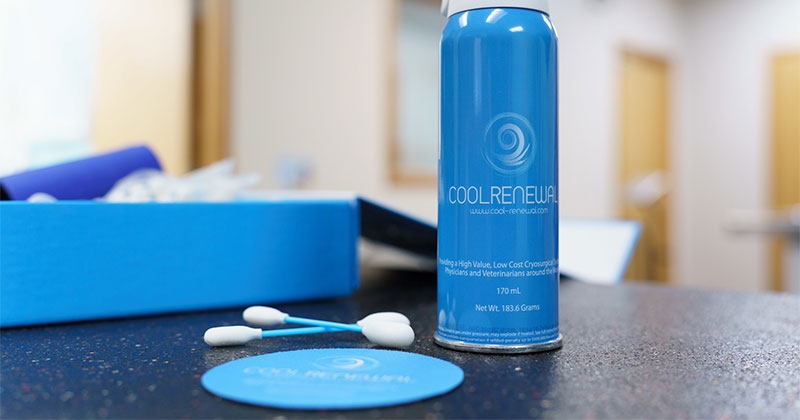
At some point, most pets will get lumps, bumps, skin tags, or warts that you’ll want to have removed. Cryosurgery with Cool Renewal is a great alternative to scalpel removal or traditional liquid nitrogen methods for removing them.
Cryosurgery means not only a shorter procedure time, but less anesthesia, if any. It can be a great alternative for pets who are not suitable candidates for an anesthetic procedure due to age or other medical reasons.
Cryosurgery is convenient, non-invasive, minimizes pain, bleeding and complications that are commonly associated with scalpel removal. In most cases, the procedure takes less than one minute!
Cryosurgery is the application of cryogen to the skin to destroy unhealthy tissue. Think of it as controlled frostbite, with little or no discomfort. Once the skin tumor is frozen, the skin may blister or turn red within a few hours or days and will eventually scab and naturally slough off within 2-3 weeks. New, healthy tissue will regenerate underneath the frozen tissue, and should return to normal color within a few weeks to months after the dead tissue has sloughed.
Papillomas (Warts): Canine Papilloma Virus, more commonly referred to as dog warts, is a common virus in dogs as well as other mammals, and are a variety of shapes and sizes. The disease is spread by contact with an infected dog, but is transmissible only to dogs and not to other humans or animals.
Skin Tags: Skin tags are thin and floppy at the base. The entire skin tag may have a flattened appearance, or it may be slightly rounded and have a tear drop shape. Skin tags tend to dangle from the skin and, unlike warts, you can move skin tags back and forth with your fingers. Skin tags are usually the same color as your dog's skin.
Sebaceous Adenomas: Present themselves as elevated, nodular masses that typically range in size between that of a pea and a large marble. These tumors are most prevalent in dogs that are over 7 years of age and often present little or no discomfort to the dog. However, in some cases they can be itchy and inflamed.
Distichia: Distichiasis is a condition where eyelashes emerge from the ducts of glands within the eyelid (Meibomian gland) which does not normally produce hairs. These "extra" eyelashes often rub on the surface of the eye and may cause irritation. Distichiasis is considered to be a breed-related problem in dogs, and is most commonly found in retrievers, spaniels, poodles, Shih Tzus, and Weimaraners.
If you’d like to find out if your pet is a good candidate or have any questions or concerns, call us at (402) 505-5445
If you’d like to contact us, call us at (402) 505-5445 or request an appointment online.
Follow us on social media: